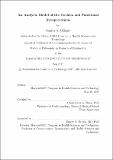| dc.contributor.advisor | Christopher A. Shera. | en_US |
| dc.contributor.author | Alkhairy, Samiya Ashraf | en_US |
| dc.contributor.other | Harvard--MIT Program in Health Sciences and Technology. | en_US |
| dc.date.accessioned | 2018-02-16T19:27:32Z | |
| dc.date.available | 2018-02-16T19:27:32Z | |
| dc.date.copyright | 2017 | en_US |
| dc.date.issued | 2017 | en_US |
| dc.identifier.uri | http://hdl.handle.net/1721.1/113732 | |
| dc.description | Thesis: Ph. D. in Biomedical Engineering, Harvard-MIT Program in Health Sciences and Technology, 2017. | en_US |
| dc.description | This electronic version was submitted by the student author. The certified thesis is available in the Institute Archives and Special Collections. | en_US |
| dc.description | Cataloged from student-submitted PDF version of thesis. | en_US |
| dc.description | Includes bibliographical references (pages 120-125). | en_US |
| dc.description.abstract | The cochlea is part of the peripheral auditory system that has unique and intriguing features - for example it acts as a wave-based frequency analyzer and amplifies traveling waves. The human cochlea is particularly interesting due to its critical role in our ability to process speech. To better understand how the cochlea works, we develop a model of the mammalian cochlea. We develop the model using a mixed physical-phenomenological approach. Specifically, we utilize existing work on the physics of classical box-representations of the cochlea, as well as the behavior of recent data-derived wavenumber estimates. We provide closed-form expressions for macromechanical responses - the pressure difference across the Organ of Corti (OoC), and the OoC velocity, as well as the response characteristics - such as bandwidth and group delay. We also provide expressions for the wavenumber of the pressure traveling wave and the impedance of the OoC that underlie these macromechanical responses and are particularly important variables which provide us with information regarding how the cochlea works; they are a window to properties such as effective stiffness, positive and negative damping or amplifier profile, incremental wavelengths, gain and decay, phase and group velocities, and dispersivity. The expressions are in terms of three model constants, which can be reduced to two constants for most applications. Spatial variation is implicitly incorporated through an assumption of scaling symmetry, which relates space and frequency, and reduces the problem to a single independent dimension. We perform and discuss various tests of the model. We then exemplify a model application by determining the wavenumber and impedance from observable response characteristics. To do so, we determine closed-form expressions for the model constants in terms of the response characteristics. Then, using these expressions, along with values for human response characteristics that are available from psychoacoustic measurements or otoacoustic emissions, we determine the human wavenumber and impedance. In addition, we determine the difference in the wavenumber and impedance in the human base (where the OoC velocity responds maximally to high frequencies), and the human apex (where the OoC velocity responds maximally to low frequencies) and discuss their interpretations. The model is primarily valid near the peak region of the traveling wave, and is linear - therefore the model, as is, does not account for cochlear nonlinearity, and hence is primarily suitable for low stimulus levels. Finally, we discuss other scientific and engineering model applications which we can pursue, as well as potential modifications to the model, including suggestions regarding incorporating nonlinearity. | en_US |
| dc.description.statementofresponsibility | by Samiya A Alkhairy. | en_US |
| dc.format.extent | 125 pages | en_US |
| dc.language.iso | eng | en_US |
| dc.publisher | Massachusetts Institute of Technology | en_US |
| dc.rights | MIT theses are protected by copyright. They may be viewed, downloaded, or printed from this source but further reproduction or distribution in any format is prohibited without written permission. | en_US |
| dc.rights.uri | http://dspace.mit.edu/handle/1721.1/7582 | en_US |
| dc.subject | Harvard--MIT Program in Health Sciences and Technology. | en_US |
| dc.title | An analytic model of the Cochlea and functional interpretations | en_US |
| dc.type | Thesis | en_US |
| dc.description.degree | Ph. D. in Biomedical Engineering | en_US |
| dc.contributor.department | Harvard University--MIT Division of Health Sciences and Technology | |
| dc.identifier.oclc | 1022848466 | en_US |
